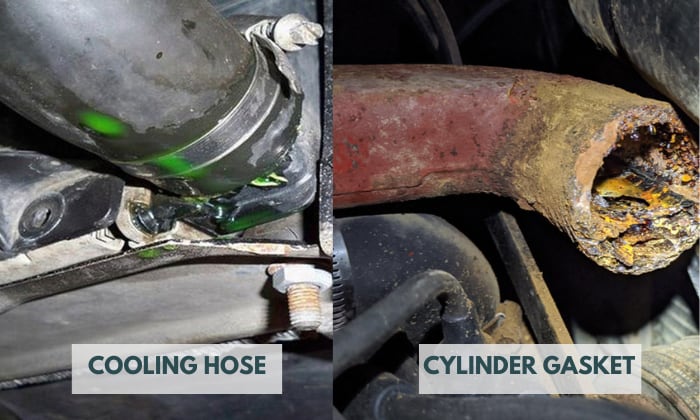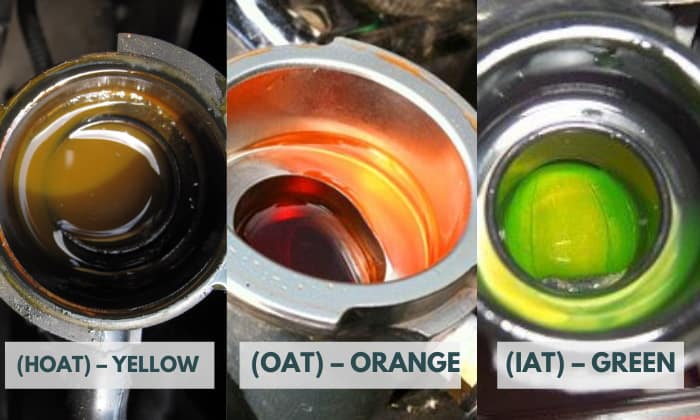You can’t use an RV antifreeze for your car. That’s because an RV antifreeze and a regular antifreeze are different products with distinct roles for their type of vehicle.
RV antifreeze is formulated to protect your motor home’s plumbing from the cold weather. On the other hand, regular car antifreeze is a toxic agent, ultilized to keep your engine’s cooling system from freezing.
So if you’re still looking for the answer, ‘Can you use RV antifreeze in a car?’, it ends here. We’re telling you – it’s really a no. Here’s an in-depth explanation of why.
Page Contents
Reasons Why RV Antifreeze May Not Be Suitable for Cars
While you got a glimpse of why you can’t use this type of antifreeze, there are many more reasons why you shouldn’t put RV antifreeze in a car.
1. Different boiling points: Coolant and defroster
Different kinds of antifreeze have different cooling techniques. An RV coolant is made to only ‘cool’, thus acting as the coolant for the vehicle.
Meanwhile, car antifreeze is in charge of ‘defrosting’, as it ensures that the water in the car radiator does not evaporate, boil or be frozen due to changes in temperatures.
And because of these property differences, they are formulated differently with different freezing and boiling points.
As such, RV antifreeze tends to have a lower boiling point compared to auto antifreeze. So, overheating may become your problem.
2. Different chemicals
Car antifreeze uses ethylene glycol, a yellow or green toxic chemical. RV antifreeze uses propylene glycol, a bright pink non-poisonous chemical.
While these may not have a significant effect since you won’t be consuming these liquids, interchanging the auto antifreeze for RV antifreeze may cause contamination to your plumbing.
You should also not attempt to mix these chemicals, or you may end up with an aggressive acid that will only make your antifreeze useless. If this happens, flush all the chemicals out and replace them with a pure one.
Potential Consequences of Using RV Antifreeze in a Car
What happens when you use an RV antifreeze for your car? Here are some of the consequences you’ll likely face for using the wrong type of antifreeze:
1. Corroded cylinder gasket and cooling hose
Car antifreeze usually comes with additives made to lubricate your engine and protect it from corrosion. RV antifreeze may come with a small amount of these additives.
Because of that, you’re more likely to experience corrosion or worse – a complete engine failure in the long run.
2. Insufficient heat transfer and freeze protection
Because of the different freezing points and boiling points of the RV antifreeze vs car antifreeze, your antifreeze may be deemed useless. This is due to its 0 compatibility – the inability to function for its purpose.
Over time, your frozen coolants may end up damaging your engine and other cooling components. This will only lead to more problems.
Tips to Choose the Right Type of Antifreeze
The right antifreeze for your car should be the one that matches your car’s age, brand, and usage during wintertime. Here are the types of antifreeze available:
1. Inorganic Acid Technology (IAT) – Green
If you’re using an older car model, IAT generally is the compatible type of antifreeze for your car. It’s usually green in color, also known as the conventional low-silicate coolant.
The IAT coolant is usually pre-mixed and diluted already, so you’ll only need to pour them straight into your radiator. IATs need to be changed every 24,000 miles of travel, though.
2. Organic Acid Technology (OAT) – Orange
The OAT antifreeze uses organic acids as corrosion inhibitors compared to IAT, which uses silicates. OATs usually come in orange and red, particularly required for car brands like Volkswagen, VM, Saab, Lexus, Scion, and Toyota.
Red-colored antifreeze usually needs to be changed every 150,000 miles, while orange-colored ones need to be changed every 600,000 miles. Don’t mix these with nitrate or silicate to maximize their effectiveness.
3. Hybrid Organic Acid Technology (HOAT) – Yellow
HOATs are a combination of IAT and OAT. They use both silicate and organic acids as inhibitors and are used by Chrysler, Ford, and other European vehicles.
In Europe, you’ll have to use phosphate-free HOAT (usually yellow). But when you’re in Asia, you’ll have to buy a P-HOAT or HOAT with phosphate (usually blue or pink). Vehicle brands that require P-HOAT include Nissan, Hyundai, Kia, and other Asian brands.
You’ll need to replace your HOAT and P-HOAT antifreeze every 25,000 miles for ample winter protection.
Conclusion
In conclusion, using RV antifreeze in a car is not recommended. The differences in usage, formulation, boiling points, and chemicals between RV antifreeze and automotive antifreeze can lead to various consequences and potential damage to your car’s engine and cooling system.
RV antifreeze is designed to protect plumbing in motor homes, while automotive antifreeze is specifically formulated to prevent engine freezing and provide corrosion protection.
So, don’t try to interchange the two if you still have second thoughts on your question, ‘Can you use RV antifreeze in a car?’ Use the right type of car antifreeze to not cause any problems in the future.

My career journey has been marked by a variety of roles. I served as a Personal Trainer for Children, Fitness Instructor, and Home-Based Consultant in Detroit Wayne Integrated Health Network.
More than ten years of traveling in my caravan have lent me a deep appreciation of freedom. Without the shackles of being tied down to one place, I get to explore many parts of the world and relish the exhilaration that comes with discovering new things. Throughout my journey, I have been a member of FMCA (Family Motor Coach Association) since 2020. Thus, living on the road has never become boring for me.
As someone with a burning passion for traveling, I want to inspire others to adopt a nomad lifestyle to appreciate the beauty of the world. This, of course, requires a functioning vehicle that can always make you feel at home, even when you’re far away from modern life.
Therefore, I seek to put my experience to good use—helping you with your adventure on the road. As a result, I launched and managed the Outdoorbits website, where I likely share my enthusiasm for outdoor activities and health-related insights.







